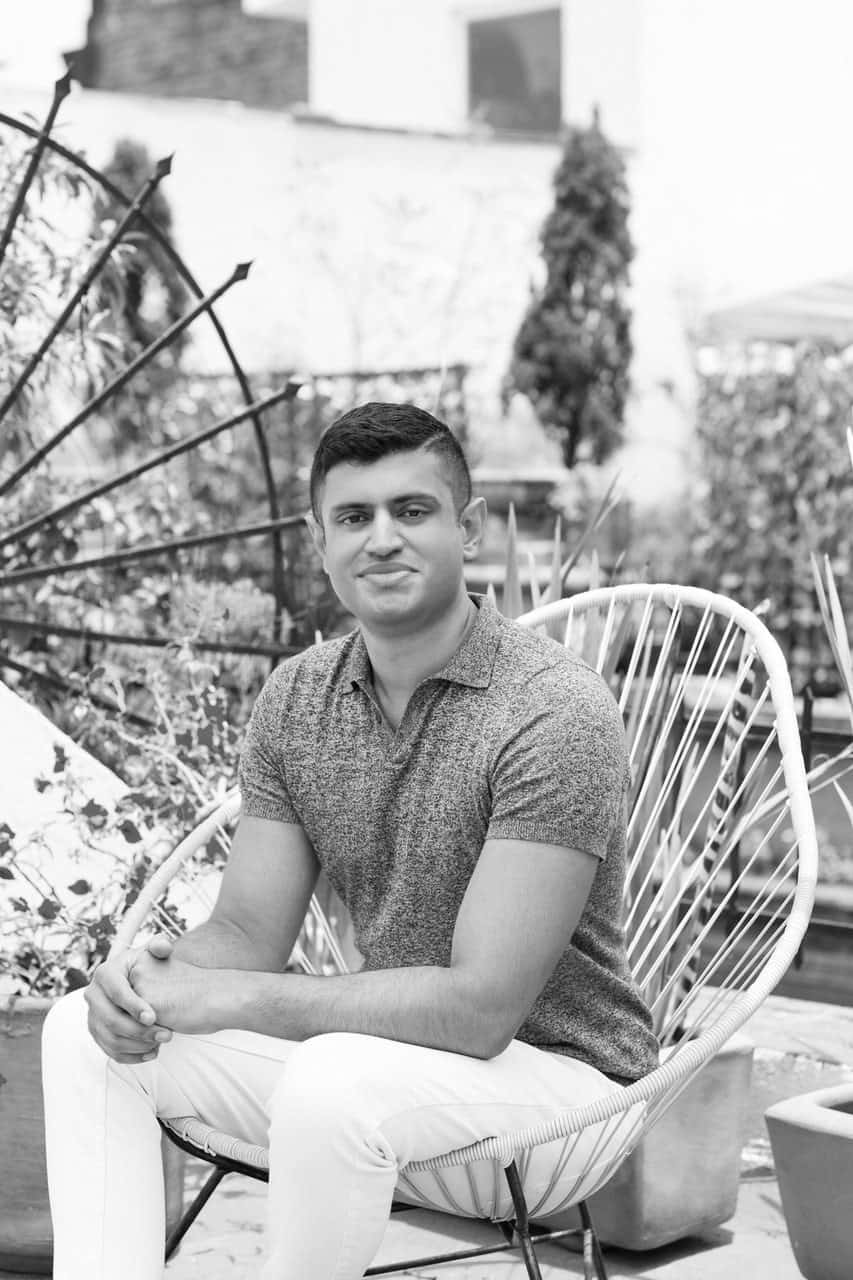
Hello Vik. Could you please introduce yourself?
Vik: Absolutely. My name is Vik Milan and I’m an interior designer and art dealer based in Los Angeles. I grew up in a suburb outside of Pittsburgh, Pennsylvania. I was definitely creative-brained in school and did well in writing, foreign languages, and art courses while pretty much failing anything that involved math or science. That said, I was keen to enter the working world even from a young age (my first job was working in a hospital cafeteria at age 13 flipping hamburgers and making French fries, an arrangement which may not have been totally legal in retrospect).
I completed my undergraduate degree at the Boston University School of Management where I concentrated in Operations & Technology Management. After college I joined AstraZeneca in its’ global operations organization. I held several roles during my four years with AstraZeneca ranging from data analytics to global project management and also had the opportunity to live and work in both Mexico City and Buenos Aires.
I enjoyed working in operations but my goal was always to start my own business. I knew that getting experience in branding and marketing would be key to rounding out my skill set and I ultimately joined IFA Paris in the MBA Luxury Brand Management program because the courses were exactly what I was looking for to build a brand of my own, not to mention the incredible opportunity to live and study in both Paris and Shanghai.
After finishing my MBA, I relocated to Seattle, Washington to start my interior design and art advisory business, Ink & Opium, while working a day job in global operations at Liberty Mutual.
In March of 2018 I decided I’d had enough of beige conference rooms and conversations consisting entirely of buzzwords and took the risky step of becoming a full-time entrepreneur. I moved to Los Angeles to build my design business while also meeting my business partner, Max Wunderlich, who provided me the opportunity to co-found SALT Gallery. I love the energy and amount of creative opportunity in LA and think this may finally be the city I call home.
You made the remarkable transition from operations in pharmaceuticals to managing creative businesses. How has this background combined with your IFA Paris education prepared you for this transition?
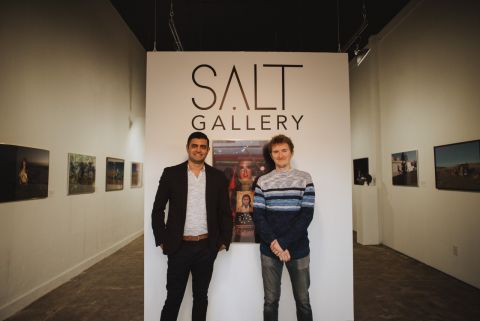
Vik Milan at his SALT Gallery
Vik: Successfully starting and operating a business requires a strong understanding of brand management, namely what differentiates your company and products in the mind of a consumer. My MBA in Luxury Brand Management gave me the tools to understand the end-to-end development of a strong, cohesive brand and what it takes to compete in the premium and luxury space.
However, maybe 75% of running a business is much less sexy and includes things like managing ordering, finances, accounting, planning, scheduling, etc. Fortunately these are skills I honed while working in operations and project management, which combined with my IFA Paris education helps make me a better-rounded business owner.
SALT Gallery is your most recent establishment. Could you tell us what inspired this move?
Vik: I’ve always had an interest in art and started collecting pieces in my early 20s. As I learned more about the art market I became interested in the business side of things. While at IFA Paris, I was able to use fine art as a topic for several research projects and also completed a certificate in ‘Art as a Global Business’ through Sotheby’s Institute of Art in my free time during our semester in Shanghai.
Fast forward to after IFA Paris when I began working as an interior designer. I always included art advising as a service to clients, who were looking to begin investing in art or simply to make strategic art purchases within the context of their design project. I knew I wanted to grow the art advising side of my business but the opportunity to do so came about through a chance meeting.
Soon after moving to Los Angeles I was at a dinner party where I happened to be seated next to Max Wunderlich, an entrepreneur who was moving into a large workshop space to house his main businesses that include ROMAN [luxury pet accessories] and SALT Limited [handmade furniture and smoking accessories]. We immediately clicked and began thinking of ways we could collaborate. He had a large space in the front of his workshop that he wanted to do something with and mentioned potentially opening a gallery. Once we realized we shared a love for art and a desire to start a gallery outpost of our own, SALT Gallery was born. We refinished the space, doing most of the manual work ourselves, finally hosting our first formal show in this past October.
Can you tell us more about the concept for SALT Gallery?
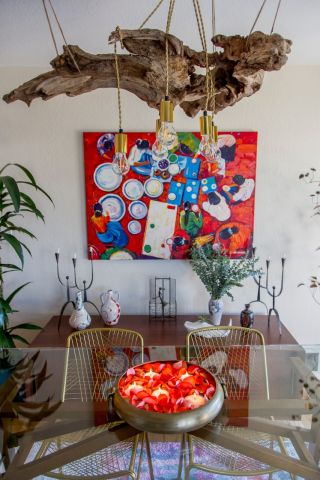
Vik Milan
Vik: To answer this question it’s probably important to first talk about what exactly an art gallery does.
There are many ways an artist can sell work independently and there is substantial value in selling through an art gallery. A gallery has dedicated resources to help promote an artist and his or her work by mounting solo or group shows and bringing in a network of buyers that the artist may otherwise not be able to meet. A good art gallery also helps artists with things like framing, scanning and digitizing original artwork, and [in or our case] providing a workshop space for artists to use. Additionally, art that is for sale in a gallery can add legitimacy to the work which helps buyers who are determining not only what artwork they gravitate towards but what they believe will be a good, high-quality investment. Some galleries may sell a wide range of work while others focus their “program” on a particular art period, subject matter, medium, or other niche.
The SALT Gallery program focuses on contemporary, surrealist works spanning a variety of mediums and subjects. Our mission is to unite emerging and established artists with customers by creating an inviting, unintimidating, and thoughtfully curated gallery experience. We want to de-mystify the process of buying art and appeal to a younger demographic looking to begin collecting pieces that speak to them and will enhance their everyday life, whether it’s a $50 print or $15,000 painting.
What role do you play as the Curator for SALT Gallery?
Vik: “Curation” is the process of finding artists that fit within our gallery program and whose work we believe in and can support. It also involves designing exhibitions and deciding what artists we’ll feature, which pieces, and how to display artwork in such a way that the pieces in an exhibition enhance one another.
To do this effectively I’ve had to change the way I evaluate art – I have to be able to judge a piece based on how effectively it communicates its intended message or idea rather than what I personally may like or dislike. Also, since SALT Gallery is an extension of my business partner’s SALT brand, my primary objective is to ensure we’re growing the business in a way that supports the brand’s longer-term objectives.
While I am, technically, a curator, I don’t like to introduce myself as such. Max and I share responsibilities in the gallery in addition to wearing multiple hats. Day-to-day you’re more likely to see me covered head to toe in white paint from touching up the walls or figuring out how to fix a sink that a sculptor has accidentally clogged with plaster (the answer is vinegar and patience, in case you were wondering).
You have founded two businesses since graduation from IFA Paris. Could you share your experience in creating and running these businesses?
Vik: When I first started doing interior design my main focus was building a strong portfolio of work to show potential clients and to establish a clear Ink & Opium brand aesthetic. This meant doing a lot of design projects at a financial loss or, best-case scenario, at break-even. It was hard sometimes to stay motivated in those situations but I loved the work I was doing which kept my momentum going. Ink & Opium was also a slow evolution since I was running the business while working a full-time corporate job. This limited the amount of interior design work I was able to take on but meant that I always had a queue of pending projects to look forward to. Now that I’m working for myself full-time I’m learning to better promote my design services to find clients outside of my social and professional network. Marketing a business is a lot like dating – you want people to know who you are and what you do but you don’t want to reveal just how desperate you might be.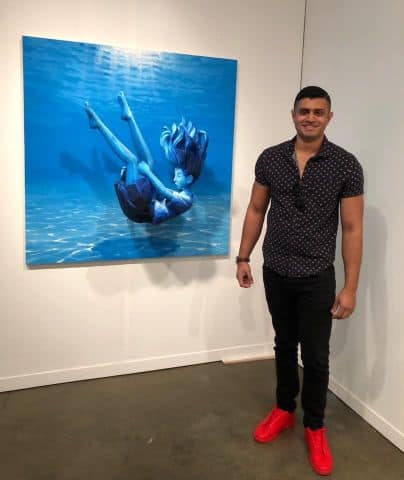
Vik Milan
SALT Gallery has been a very different experience since my business partner, Max Wunderlich, and I co-own the gallery together and already had a location to work with. We are able to share a lot of the workload and bounce ideas off one another. Having a business partner also helps keep the momentum going on days when one of you may be feeling low energy or burned out. By pooling our time, skills, and resources we have the added advantage of being able to grow the business much more quickly than a one-person operation.
How has your experience in project management contributed to these businesses?
Vik: Regardless of industry the fundamentals of project management are the same: breaking down a large undertaking into smaller, sequential tasks while managing the budgets and stakeholders required to complete the work on time. Except of course that this isn’t how real life works.
Project management is more like chaos management, being able to maintain order and sanity when tasks balloon in complexity and there is too much work to get done in not enough time. This is essentially what starting and managing a business entails and my experience managing projects in different countries with a revolving door of challenges and stakeholders helps me to stay organized and realistic even when everything seems to be going wrong or unexpected issues come up along the way.
And why did you choose IFA Paris for your MBA, and what aspects of your MBA in Luxury Brand Management have been most valuable in your journey since graduation?
Vik: When I decided to leave my career in the pharmaceutical industry to pursue an MBA, I did so with the intention of one day starting my own brand. At the time I was interested in menswear but wanted to find a program that would introduce me to other industries in the event my interests changed. I found luxury brand management intriguing because luxury brands are the pinnacle of brand design. I figured that if Hermès can sell a handbag for $50,000 there was probably something to be learned.
This IFA Paris MBA program was the best fit for me based on the course offering and the split between Paris and Shanghai campuses. I enjoyed my experience at IFA Paris because the MBA program gave us creative freedom to study brands, industries, and markets that interested us in group and individual projects. I was able to focus a lot of my project work on either mens’ lifestyle brands or fine art, both of which have benefitted me in building my interior design business and now SALT Gallery.
What I learned in the MBA program continues to be valuable to me whether in creating a design concept for a new interior design client or developing a business plan or brand strategy for a new venture. Learning how to put together professional quality mood boards has also helped me be more effective in visually communicating ideas.
Working in the contemporary art world requires you to break into a very exclusive community. How did you navigate this space?
Vik: The fine art world definitely has a stereotype of being exclusive and closely guarded especially the relationships between galleries, artists, and buyers. It’s also not uncommon to attend art events where the entire crowd seems to dressed in all black with thick-framed glasses – not always the most inviting setting.
In terms of how I was able to “break into” this community, it happened through a combination of effort and luck. Once I identified fine art as a business I was serious about getting into I made sure to attend as many museum exhibitions, art gallery open nights, and art fairs as possible. I was fortunate to have several established artists in my friend group but had no connections in the gallery community. Visiting galleries and not being afraid to ask questions helped me to become more comfortable in the art world – I found most people to be welcoming and friendly if you show genuine interest.
The art world can be exclusive but it shouldn’t feel intimidating. I still have a lot to learn and am not sure I can say I’ve “broken into” the art world yet, but doing so will take a lifetime of work and continued development both on my part and that of SALT Gallery. And I’ll probably need to buy more all-black outfits.
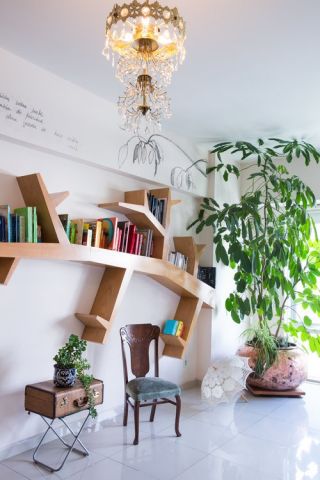
Vik Milan
What major milestones are you looking forward to this year with Ink & Opium and SALT Gallery?
Vik: This year I’m looking forward to undertaking new interior design projects at Ink & Opium, hopefully trying my hand at a commercial design project. I’m also planning to launch a small line of branded home accessories later this year.
For SALT Gallery, this year we’re looking forward to reimagining the gallery as more of a concept store which focuses on fine art and offers a carefully chosen assortment of additional products that compliment the SALT brand. We also want to strengthen our relationship with artist by allocating more time for studio visits and attending art fairs and festivals.
Another priority is to build our digital gallery so that we can showcase and sell artwork online, which is where many buyers now prefer to research and purchase art. A digital gallery will also allow us to access customers outside of Los Angeles and showcase a broader selection of work than we can in the physical gallery space. We currently offer fine art prints through the digital gallery but plan to expand into higher value original pieces.
What advice do you have for students looking to get into the business of art?
Vik: Running an art business and putting together exhibitions requires knowledge of fine art, trends in the art world, and tapping into a network of artists, galleries, framers, hangers, shippers, insurance brokers, and others. It also requires constant learning since the art market is always changing. This shouldn’t intimidate students who are interested in the art world but rather provide an interesting challenge. Ultimately you can learn anything through experience.
My advice to students looking to enter into the art business is to continue learning as much as possible both through self-study and/or taking courses on art dealing or art history. Equally important is looking for gallery shows and museum exhibitions to visit, many of which are listed online and open to the public. Going to art museums will help you become familiar with art history, major artists and time periods, mediums, etc. that will make it easier to understand contemporary art and artists currently working in the field.
Additionally, I think it would be a disservice to students not to mention that running an art gallery is a challenging business – sales can be sporadic with long periods without sales and there is fierce competition in the industry. New galleries need to find a niche in the market or help satisfy an unmet customer need. It is also important to think of multiple ways to monetize a gallery space whether through events, space rentals, or pop-up shops during the beginning stages unless you have the resources to sustain the business without income for an extended period of time.
Creativity goes a long way in this industry both in how you define your unique brand and how you run your business. It’s important to learn about the art world but more important to do things your own way.
For more infos on the program Vik pursued at IFA Paris, please visit MBA in Luxury Brand Management